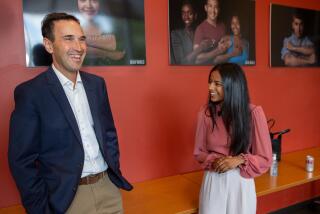Steve Jobs’ virtual DNA to be fostered in Apple University
- Share via
Reporting from San Francisco — Apple Inc. now has to get down to the business of surviving its founder.
It’s something that Apple — and Steve Jobs himself — had been painstakingly planning for years.
Deep inside its sprawling Cupertino, Calif., campus, one of the world’s most successful and secretive companies has had a team of experts hard at work on a closely guarded project.
PHOTOS: The life of Steve Jobs
But it isn’t a cool new gadget. It’s an executive training program called Apple University that Jobs considered vital to the company’s future: Teaching Apple executives to think like him.
“Steve was looking to his legacy. The idea was to take what is unique about Apple and create a forum that can impart that DNA to future generations of Apple employees,” said a former Apple executive who spoke on the condition of anonymity to preserve his relationship with the company. “No other company has a university charged with probing so deeply into the roots of what makes the company so successful.”
Jobs oversaw the most remarkable corporate turnaround in Silicon Valley history after returning to Apple in 1997. For more than a decade, he was behind every crucial decision as Apple rolled out blockbuster hits from the iPod to the iPad, changing how people listen to music and watch entertainment, reshaping entire industries and making Apple the world’s most valuable tech company.
The challenge of maintaining that momentum came into sharp focus Tuesday when Apple’s newly minted chief executive Tim Cook took Jobs’ place on stage to show off an updated version of the world’s best-selling smart phone. Without its master pitchman, Apple didn’t get the kind of adulation for the iPhone’s new features to which it’s accustomed.
Apple would not comment on Apple University. But people familiar with the project say Jobs personally recruited the dean of Yale’s Business School in 2008 to run it. Joel Podolny’s assignment: Help Apple internalize the thoughts of its visionary founder to prepare for the day when he’s not around anymore.
“One of the things that Steve Jobs understood very well is that Apple is like no other company on the planet,” said longtime Apple analyst Tim Bajarin. “It became pretty clear that Apple needed a set of educational materials so that Apple employees could learn to think and make decisions as if they were Steve Jobs.”
Podolny tasked leading business professors including Harvard University’s Richard Tedlow, who wrote a biography of former Intel chief Andy Grove with researching the company’s major decisions and the top executives who make them. Those executives — including Cook — have used those case studies to teach courses that groom the company’s next generation of leaders.
Analysts say Jobs drew inspiration for the university from Bill Hewlett and David Packard, whose greatest creation was not the pocket calculator or the minicomputer, but Hewlett-Packard itself. Hewlett and Packard famously set out their company’s core values in “The HP Way.”
With Apple University, Jobs was trying to achieve something similar, people familiar with the project say. He identified tenets that he believes unleash innovation and sustain success at Apple — accountability, attention to detail, perfectionism, simplicity, secrecy. And he oversaw the creation of university-caliber courses that demonstrate how those principles translate into business strategies and operating practices.
The idea of building an ivory tower on a corporate campus goes back decades with the best-known — and oldest — run by General Electric. Corporate universities fell out of favor in the 1990s, considered too expensive, bureaucratic and out of touch with the companies they were supposed to serve. Even Apple shut down its corporate university.
But Jobs’ interest in a corporate university never wavered, former employees say. For years he pressed for a way to study the success of Apple’s executive team as well as Apple’s culture and history. His model was Pixar. The animation studio that Jobs sold to Disney for $7.5 billion in 2006 runs Pixar University, a professional development program that offers courses in fine arts and filmmaking as well as leadership and management to steep employees in the company’s culture, history and values as well as its craft.
“He had the university concept at Pixar, and he believed in it,” said a former Apple executive who also spoke on the condition of anonymity to preserve his relationship with the company.
What Jobs needed was someone to carry out his vision.
Apple began approaching Podolny and other academics about five years ago, according to people who were contacted. The project took on greater urgency in 2008 shortly before Jobs took his second medical leave from Apple.
Podolny, an accomplished scholar and administrator whose resume includes teaching at two of the nation’s top business schools, Stanford and Harvard, is an economic sociologist who focuses on leadership and organizational behavior.
Podolny didn’t just study leaders; he became one. In 2005, at the age of 39, he left Harvard for the Yale School of Management where he rethought how the faculty taught future MBAs to better prepare them for the business world. Yale scrapped its staid single-subject courses in marketing and accounting for more holistic, multidisciplinary programs that focused on “the employee,” “the innovator” and “the state and society.”
By all accounts, Podolny lifted the fortunes of the young business school. He was credited with helping applications rise 50% during his 3½-year tenure. He recruited top scholars, increasing the size of the faculty by 20%. And his prodigious efforts on the stump helped the school raise more than $170 million. He was also in the classroom more often than most deans and responded to every email, frequently by 4:30 a.m.
“I remember scratching my head and thinking, ‘This guy is not going to last at this rate.’ Sure enough, he left sooner than we had hoped,” Yale business professor Doug Rae said.
In October 2008, Podolny was at the top of his academic game with many expecting he would go on to become a university president. He stunned colleagues by abruptly stepping down as dean in the middle of the term and officially joining Apple in early 2009.
“The timing surprised everyone. Deans are typically in these positions for significantly longer; a decade would not be an unusual term. He had gone to really put the Yale School of Management on a different trajectory and that takes time,” said Garth Saloner, dean of Stanford’s Business School.
But Podolny was someone who had flouted convention to work on the cutting edge of academia. “Joel is an innovator and very creative and he’s always looking for new areas to apply that talent,” Saloner said.
Like others Jobs has recruited over the years, observers say Podolny fell under Jobs’ spell. Podolny said he decided to leave Yale for the chance to work with a modern-day Thomas Edison.
Podolny recalled writing his first computer program on an Apple II and pulling an all-nighter to watch his Laserwriter print his undergraduate thesis at the rate of seven minutes a page.
“While there are many great companies, I cannot think of one that has had as tremendous personal meaning for me as Apple,” he wrote in a farewell note to Yale students.
The importance of his new position at Apple was apparent from the first day. Podolny moved into an office in between Jobs and Cook, he confided in former colleagues. And, in a testament to Jobs’ faith in Podolny, he was later named vice president of human resources.
Columbia University social scientist Peter Bearman, who was Podolny’s advisor for his thesis on the role of Juan Carlos I in helping Spain establish a parliamentary democracy, said Podolny pursued his career-long interest in leadership at Apple.
“The idea that he was helping to build a structure for Apple into the future probably appealed to him,” Bearman said.
FULL COVERAGE: Steve Jobs | 1955-2011






